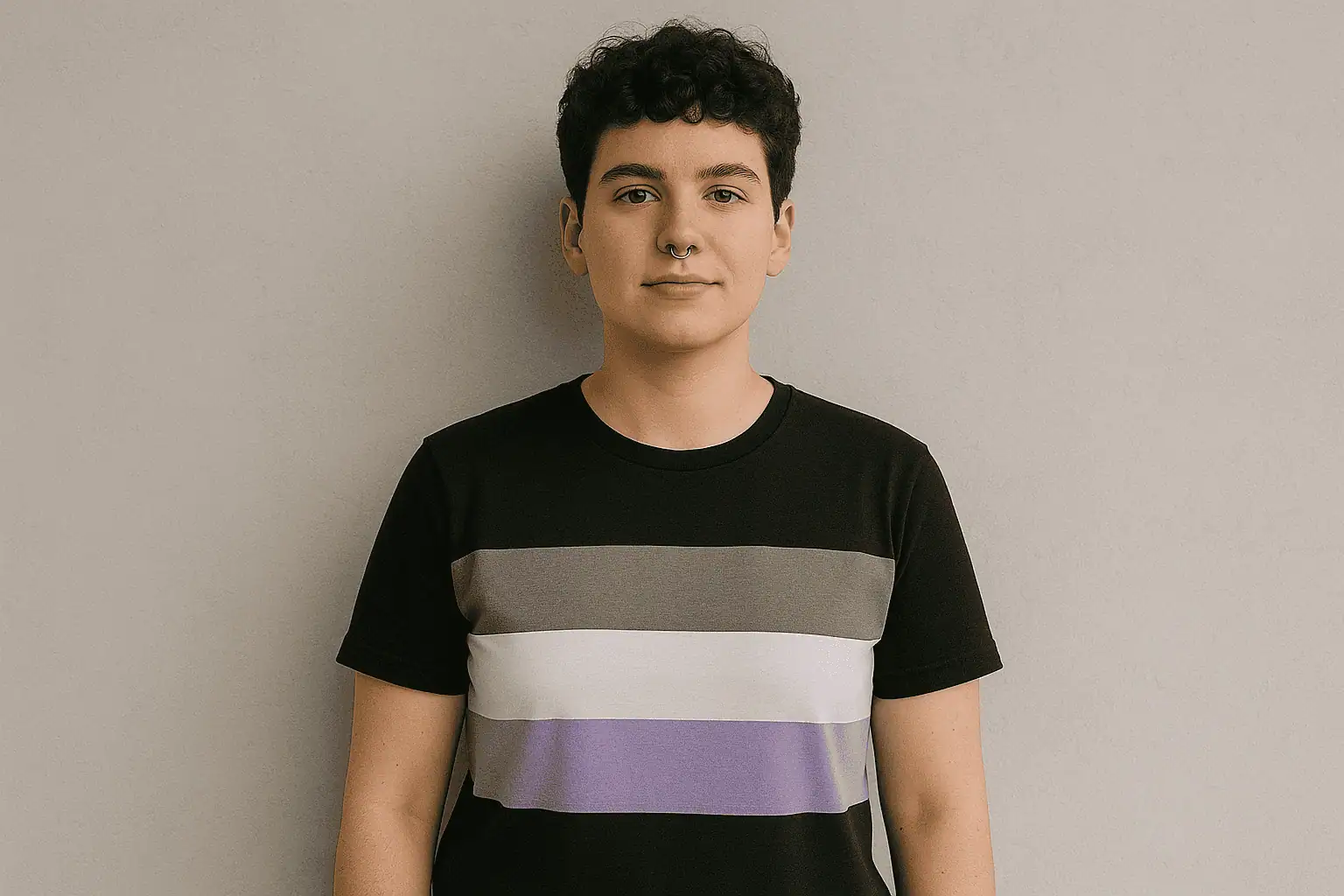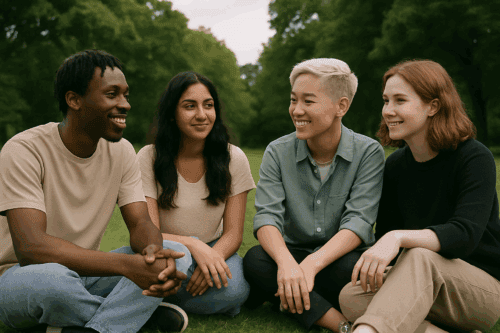
Asexual Spectrum Explained: Redefining Desire
Asexuality is one of the most misunderstood aspects of human sexuality. The asexual spectrum includes people who experience little or no sexual attraction yet still seek deep emotional, romantic, or intellectual connection. The term asexual refers to individuals who do not experience sexual attraction, and this is distinct from abstinence or lack of sexual activity. To understand this identity, we must separate sexual attraction from other kinds of attraction—romantic, aesthetic, sensual, and emotional. Each exists independently, creating countless ways people relate to others. Asexual identity is a valid and distinct sexual orientation within the broader spectrum of human sexuality.
For some, the idea of not feeling sexual desire may seem foreign. But for those who identify as asexual, demisexual, or gray asexual, it simply describes how they move through the world—some may not feel attraction at all, while others may experience it differently. The asexual spectrum explained here shows that intimacy is not defined by sex; it’s defined by connection, consent, and authenticity.
Understanding Asexuality and the Asexual Spectrum
Asexuality is the lack of sexual attraction to others or a low or absent interest in sexual activity. An asexual person might still fall in love, form a family, or pursue a romantic relationship, but without the drive for sexual intimacy. Each ace person has a unique experience and identity, reflecting the diversity within the asexual community. Asexuality can be considered a sexual orientation or, in some cases, the lack thereof. Identifying as asexual is an important step for many in understanding themselves and embracing their orientation. It differs completely from celibacy or abstention, which are choices rather than orientations.
Asexual people experience the full range of human emotion. Many feel romantic attraction, some experience aesthetic admiration, and others enjoy physical closeness without any sexual connection. The ace spectrum recognizes that romantic attraction is separate from sexual attraction. You can desire emotional or romantic closeness while feeling no urge to have sex. There is a wide variety in how asexuals experience attraction and relationships, highlighting the spectrum of feelings and connections within the community.
Within the asexual spectrum are individuals who identify as demisexual or gray asexual. Demisexual individuals feel sexual attraction only after forming a strong emotional bond. Gray asexual people may rarely experience sexual attraction or only under specific circumstances. Together, they show that attraction operates on a spectrum rather than a simple on-off switch.
Asexuality and Misunderstanding
Asexuality is distinct from any medical or psychological disorder. While some confuse it with hypoactive sexual desire disorder, the two are not the same. The latter involves distress or concern about low sexual desire; asexuality does not. Asexual individuals are not broken or repressed—they simply experience desire differently. Asexuality is a natural variation of human sexuality, in the same way that homosexuality or bisexuality are.
The ace spectrum includes a wide range of identities and experiences. Understanding differences among individuals is key to appreciating the diversity within the asexual community. Some asexual individuals may have sexual fantasy, which can vary greatly and does not necessarily align with their experience of sexual attraction.

Diversity of Experiences in Asexuality
The ace spectrum is broad and beautifully varied. Some asexual people engage in sexual activity despite lacking attraction—perhaps to bond with a partner, have children, or explore intimacy on their own terms. Others avoid sexual acts entirely. This variety highlights that being ace doesn’t dictate behavior; it describes attraction. Persons on the ace spectrum may have different experiences and preferences regarding intimacy and relationships. While societal expectations often emphasize sexual exploration and having multiple partners, many asexual individuals find fulfillment outside of these norms.
Asexual individuals may identify as sex-repulsed, sex-neutral, or sex-positive.
- Sex-repulsed aces prefer to avoid sexual situations.
- Sex-neutral aces feel indifferent.
- Sex-positive aces are open to sex as one of many forms of connection.
Romantic orientation adds another layer. Asexual individuals may be heteroromantic, homoromantic, biromantic, panromantic, or aromantic. For instance, an aromantic asexual person may desire companionship without romantic or sexual involvement, while a biromantic asexual may crave love and partnership without the element of sex. Not all asexual people lack romantic attractions; some experience strong romantic feelings even in the absence of sexual attraction. Romantic and sexual orientation can differ entirely—proof that human connection is far more complex than biology alone.
The Split Attraction Model and Identity Fluidity
The split attraction model helps explain this. It separates romantic and sexual attraction, showing that people can experience one without the other. A person may feel romantically attracted yet never experience sexual attraction, or vice versa. Recognizing this distinction normalizes the diverse experiences within the asexual community.
Some asexual people identify as aceflux, meaning their feelings about attraction fluctuate over time. Others use terms like graysexual to describe occasional attraction. Persons identifying with these labels, or who are exploring their identities, help illustrate the spectrum and diversity within the ace community. This language empowers individuals to express themselves more accurately. No two asexual experiences are identical, and that diversity is the heart of the ace community.
Misconceptions and Challenges Faced by Asexual Individuals
Misunderstandings about asexuality are widespread. Many people assume it’s a phase, a choice, or a medical issue. Some believe asexual individuals simply haven’t met the “right person.” These misconceptions can be deeply isolating and lead to negative feelings or self-doubt. Not everyone is sexually attracted to others, and this is a normal variation in human experience.
Asexual people frequently face societal pressure to conform to a sexual norm. Modern culture often treats sexual activity as proof of love or success, leaving those without sexual desire feeling invisible. Variations in sex drive are often misunderstood, with low or absent sex drive sometimes wrongly seen as a problem to be fixed. The ace spectrum challenges compulsory sexuality—the idea that society pressures everyone to want or engage in sex to feel fulfilled.
Because asexuality defies expectations, some professionals misdiagnose individuals with sexual interest or arousal disorders. Many people mistake a lack of sexual desire for a clinical issue, even though asexuality represents a natural orientation.
In clinical contexts, a diagnosis like hypoactive sexual desire disorder requires marked distress about low desire, which is not present for most asexual people. Others are told they must “fix” themselves. In reality, asexuality reveals that desire and attraction are not universal or required for a complete life. Everyone experiences desire differently, and not experiencing sexual attraction is as natural as any other variation of human sexuality.
Social isolation and misunderstanding can contribute to mental health challenges such as anxiety and depression. Many asexual people report feeling alienated in a world that prioritizes sexual expression. The lack of accurate representation in media and education only adds to the burden. When aces share their stories, however, the narrative shifts—showing that they are perfectly normal and whole just as they are.
Mental Health Considerations for Asexual Individuals
Mental health is a vital part of overall well-being, and for asexual individuals, navigating a world that often centers on sexual attraction and sexual desire can present unique challenges. The ace community—encompassing asexual people, gray asexuals, sex positive aces, and those with a range of romantic orientations—often faces misunderstanding and invisibility, which can impact mental health in significant ways.
Asexual people may struggle with feeling isolated or misunderstood, especially when their lack of sexual attraction or low sexual desire is dismissed or pathologized. Too often, asexual individuals are misdiagnosed with conditions like hypoactive sexual desire disorder, when in reality, their experience is a natural and valid sexual identity. The American Psychiatric Association recognizes that asexuality is not a disorder, and it’s crucial for both professionals and loved ones to approach asexuality with respect and understanding.
Romantic Attraction and Emotional Well-Being
Romantic attraction and romantic relationships can also be sources of confusion or stress. While some asexual people experience romantic attraction and seek romantic relationships, others do not—aromantic describes those who do not experience romantic attraction at all. This diversity within the asexual spectrum means that each person’s needs and desires around connection, intimacy, and partnership are unique. For some, a lack of sexual or romantic attraction is simply part of who they are, not something to be “fixed.”
The lack of representation of asexual identities in media, education, and even within the broader queer community can lead to feelings of invisibility. Many asexual individuals report internalized shame or guilt, especially when friends talk about sexual experiences or when societal messages equate sexual activity with happiness and fulfillment. This pressure to conform can contribute to anxiety, depression, or negative feelings about one’s own sexual identity.
Some asexual people may also have experienced trauma or PTSD related to their sexual or romantic experiences, or from being pressured into sexual activities that did not align with their desires. It’s important to recognize that mental health challenges are not inherent to being asexual, but often arise from a lack of acceptance and understanding in society.
Supporting Mental Health in the Ace Community
Supporting the mental health of asexual individuals starts with education and visibility. Providing accurate information about the asexual spectrum, including the experiences of gray asexuals, sex positive aces, and aromantic individuals, helps normalize these identities as part of the rich diversity of human sexuality. Promoting acceptance—both within families and in the wider community—can reduce stigma and foster a sense of belonging.
Respecting individual boundaries and choices is essential. Asexual people, like anyone else, deserve to have their preferences around sexual activity, romantic relationships, and intimacy honored without pressure or judgment. Access to inclusive, affirming therapy—where asexuality is understood as a valid sexual orientation, not a symptom—can be life-changing for those navigating mental health challenges.
Ultimately, supporting the mental health of asexual individuals means creating a world where every person, regardless of how they experience sexual or romantic attraction, feels seen, respected, and valued. By embracing the full spectrum of human sexuality, we can help ensure that asexual people thrive—mentally, emotionally, and socially.
Resources and Support for Asexual Individuals
Awareness and community have grown rapidly in recent years. The Asexual Visibility and Education Network (AVEN), founded in 2001, remains one of the most trusted resources for information and support. It offers forums, guides, and educational content for both questioning individuals and allies.
Online spaces such as TikTok, Tumblr, and Instagram host active ace communities. Here, members share personal stories, artwork, and humor that reflect their daily experiences. The visibility of ace creators helps others realize they’re not alone.
Therapy can also be valuable, especially when guided by LGBTQ-affirming or ace-aware counselors. Talking to a professional who understands the nuances of sexual orientation can help individuals navigate relationships or family discussions. Asexuality itself is not a medical condition that requires treatment, but social acceptance and self-understanding often benefit from supportive conversation.
Books, podcasts, and documentaries continue to expand ace representation. More fictional characters now reflect gray asexual or demisexual identities, helping audiences see that these experiences are real and diverse. Representation in media normalizes what education often ignores—human sexuality is not one-size-fits-all. Asexual activists, such as Yasmin Benoit, play a crucial role in increasing visibility and advocating for asexual inclusion in broader conversations about sexuality.
Research using a national probability sample has helped establish the prevalence of asexuality in the general population, providing more accurate and representative data. Studies have also identified associated factors, such as societal attitudes, mental health, and demographic variables, that can influence asexual experiences. Ongoing sex research is essential for deepening our understanding of the asexual spectrum and ensuring that support and resources are informed by scientific evidence.

Relationships Beyond Attraction
One of the most beautiful truths the ace spectrum offers is that fulfilling relationships can exist without sexual attraction. Many asexual people form deep romantic relationships built on trust, companionship, and shared values rather than sexual intimacy. Love can thrive through emotional, intellectual, or spiritual connection. Some asexual people may also choose to have a sexual relationship, even if they do not experience sexual attraction, as part of their personal journey or to meet the needs of a partner.
Some asexual individuals are in romantic partnerships that include affection, cuddling, or kissing but not sex. Others prefer queerplatonic relationships, close emotional bonds that go beyond friendship but remain non-sexual. These partnerships prove that emotional connection can be as strong, if not stronger, than physical intimacy.
Asexual people can also form families, co-parent, or live with partners without traditional sexual behavior. Communication is key: setting boundaries, understanding comfort levels, and respecting differences. Some aces date allosexual (non-ace) partners who accommodate their preferences through mutual understanding. Others find love within the ace community itself.
Asexuality doesn’t erase desire—it redefines it. Desire can be emotional closeness, companionship, or the longing to be understood. Every person on the asexual spectrum interprets desire in their own way, and there is a wide diversity of sexual experience among ace individuals, including variations in sexual desire, fantasies, and emotions. What unites them is the belief that connection does not require sex to be meaningful.
Redefining Desire
Understanding asexuality expands our concept of what it means to be human. It reminds us that attraction, love, and fulfillment take many forms. Asexual individuals prove that intimacy and identity are not dependent on sexual acts but on honesty and consent.
At Jack and Jill Adult, we believe every form of connection deserves respect—from passionate romance to quiet companionship. The asexual spectrum encourages everyone to rethink what intimacy really means and to celebrate desire in all its expressions. Whether someone experiences sexual attraction, romantic attraction, or none at all, every experience of desire—and every absence of it—is valid.
Asexuality isn’t about lack; it’s about authenticity. It shows that being true to your own experience of attraction, whatever it may be, is the deepest form of desire there is.

